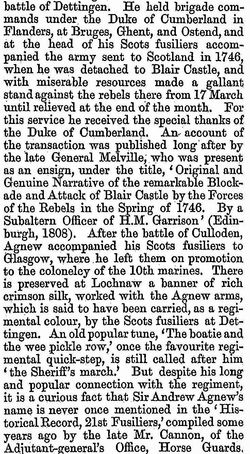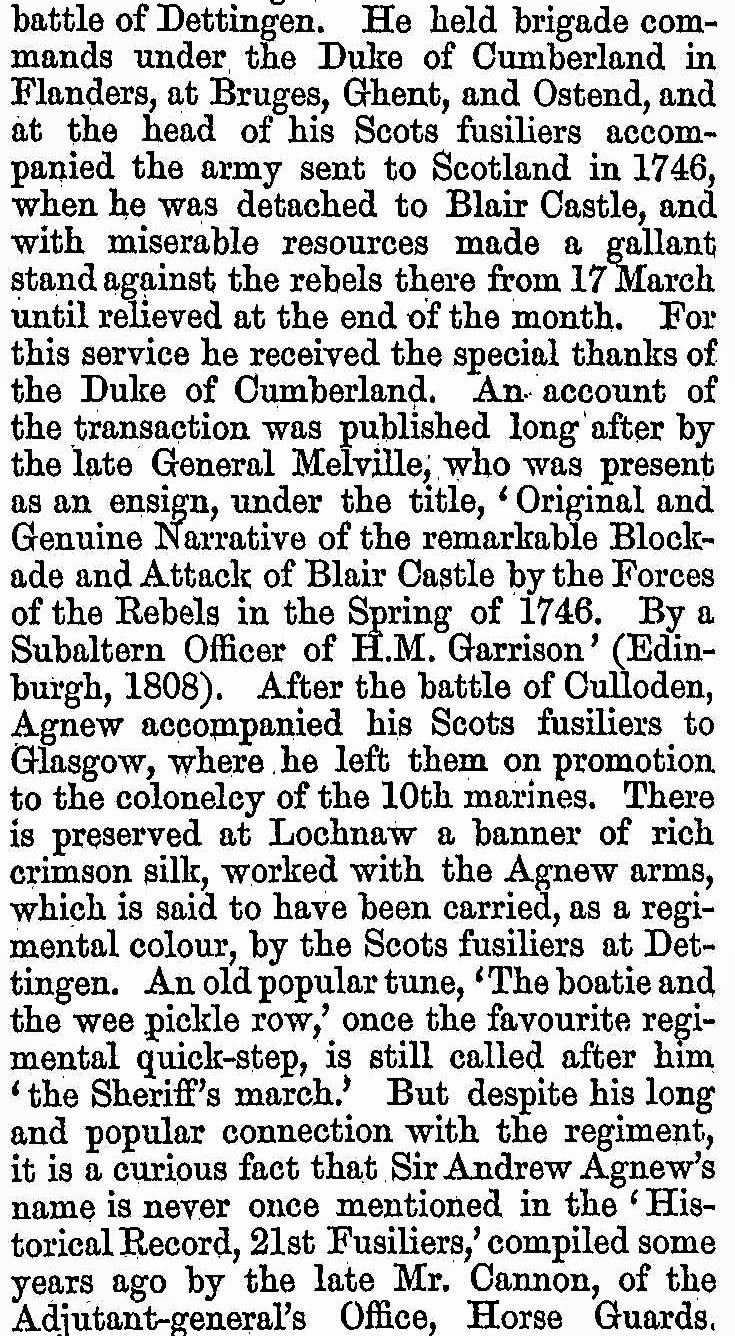Son of Sir James, 4th Baronet of Lochnaw.
Eldest brother of his 20 brother's & sisters.
Lt. General Sir Andrew Agnew
5th Baronet of Lochnaw, was known locally in his home of Galloway as "The Sheriff".
Married to Eleanor Agnew, daughter of Captain Thomas Agnew.
Eleanor's dad fought alongside Captain Andrew Agnew in the same Regiment, the Royal Scottish Dragoons.
Father of 18children.
~~~~~~~~~~~~~~~~~~~~~~~~~~~~~~
MILITARY
Regiment: Royal Scot's Fusiliers.
Unit: 21st Battalion.
Service No: -
Rank: Lieutenant General.
*
Initial Regiment: Marlborough's Army.
Unit: Volunteer.
~
Military Service:
Battle of Blenheim - 13 August [O.S. 2 August] 1704.
A major battle of the War of the Spanish Succession.
Marshal Tallard, the French commander, surrendered to the Duke of Marlborough at Blenheim after a spectacular defeat of the hitherto invincible French army of Louis XIV on 2nd August 1704.
The overwhelming Allied victory ensured the safety of Vienna from the Franco-Bavarian army, thus preventing the collapse of the reconstituted Grand Alliance.
**
11.5.1705: Commissioned as Cornet
Regiment: Royal Scottish Dragoons. (Lord John Hay's).
[Regiment now known as the Scot's Greys.)
Military Service:
Ramiliies - 23 May 1706
A battle of the War of the Spanish Succession.
For the Grand Alliance – Austria, England, and the Dutch Republic – the battle had followed an indecisive campaign against the Bourbon armies of King Louis XIV of France in 1705.
Victory won by Allied (Anglo-Dutch) forces led by the Duke of Marlborough over the French
Oudenarde Battle - 11 July 1708. (O.S 30th June 1708 Flanders)
The Duke of Marlborough's third defeat in the field of the French army of Louis XIV.
A major engagement of the War of the Spanish Succession.
Eighty thousand men under the command of the Duke of Marlborough and Prince Eugene of Savoy against a French force of eighty-five thousand men under the command of the Duc de Bourgogne and the Duc de Vendôme, the battle resulting in a great victory for the Grand Alliance.
The battle was fought near the city of Oudenaarde, at the time part of the Spanish Netherlands, on 11 July 1708.
The battle was fought in the later years of the war, a conflict that had come about as a result of English, Dutch and Habsburg apprehension at the possibility of a Bourbon succeeding the deceased King of Spain, Charles II, and combining their two nations and empires into one.
Malplaquet Battle - 11th September 1709. (In Northern France near the Belgian border.)
The Duke of Marlborough's fourth, bloodiest and least
conclusive defeat in the field of the French army of Louis XIV.
During peacetime in Utrecht, Netherlands his rank was Captain.
***
1715 - 1716: Rebellion.
Regiment: Colonel Pocock's Regiment. (disbanded Eire 1718).
Transferred to Regiment: Royal Scot's Fusiliers.
Unit: 21st Battalion.
1740 Promoted: Lieutenant Colonel.
~
Service inc.
Battle of Dettingen. 27th June 1743 (O.S. 16th June 1743).
The last battle, at which a British King was present, King George II:
A victory for the Pragmatic Army led, nominally, by King George II alongside Duke of Cumberland.
fought in South West Germany on the North bank of the Main river some 70 miles East of Frankfurt and 3 miles West of Aschaffenburg.
Combatants at the Battle of Dettingen:
The Pragmatic Army comprising British, Hanoverians and Austrians against a French Army.
General Earl of Stair was in nominal overall command.
Lieutenant Colonel Sir Andrew Agnew of Lochaw warned his Royal Scots Fusiliers not to fire until they could 'see the whites of their e'en'.
The Duke of Cumberland was wounded by a bullet in the leg during the battle. He was troubled by this injury for the rest of his life.
'Handel wrote a Te Deum and an anthem in celebration of the victory.'
Generals at the Battle of Dettingen:
George II, King of England and Elector of Hanover, Earl of Stair, Marshall Konigseck, Duc D'Ahremburg, General Ilton (Hanover).
The French were commanded by the Duc de Noailles and the force that crossed the Main was commanded by the Comte de Grammont.
Size of the Armies at the Battle of Dettingen:
70,000 French and 50,000 British and allied troops.
~~~~~~~~~~~~~~~~~~~~~~~~~~~~~~~~~~~~~~~~~~~~~~~~~~~~~
After Andrew's military service, he returned home continuing the charge of 'Sheriff of Galloway, Justice of the Peace' which he commenced in 1723 after his father resigned the post in favour of his son.
As a Magistrate, he was "shrewd, kindly, and true-hearted, despite his eccentricities.
Sir Walter Scott described him as 'a soldier of the old school, stiff and formal in manner, brave to the last degree, and something of a humourist'. (Hist. of Scotland):"
*
Died: Leswalt, (Lochnaw Castle), Wigtownshire, Rhinns of Galloway, Scotland.
Son of Sir James, 4th Baronet of Lochnaw.
Eldest brother of his 20 brother's & sisters.
Lt. General Sir Andrew Agnew
5th Baronet of Lochnaw, was known locally in his home of Galloway as "The Sheriff".
Married to Eleanor Agnew, daughter of Captain Thomas Agnew.
Eleanor's dad fought alongside Captain Andrew Agnew in the same Regiment, the Royal Scottish Dragoons.
Father of 18children.
~~~~~~~~~~~~~~~~~~~~~~~~~~~~~~
MILITARY
Regiment: Royal Scot's Fusiliers.
Unit: 21st Battalion.
Service No: -
Rank: Lieutenant General.
*
Initial Regiment: Marlborough's Army.
Unit: Volunteer.
~
Military Service:
Battle of Blenheim - 13 August [O.S. 2 August] 1704.
A major battle of the War of the Spanish Succession.
Marshal Tallard, the French commander, surrendered to the Duke of Marlborough at Blenheim after a spectacular defeat of the hitherto invincible French army of Louis XIV on 2nd August 1704.
The overwhelming Allied victory ensured the safety of Vienna from the Franco-Bavarian army, thus preventing the collapse of the reconstituted Grand Alliance.
**
11.5.1705: Commissioned as Cornet
Regiment: Royal Scottish Dragoons. (Lord John Hay's).
[Regiment now known as the Scot's Greys.)
Military Service:
Ramiliies - 23 May 1706
A battle of the War of the Spanish Succession.
For the Grand Alliance – Austria, England, and the Dutch Republic – the battle had followed an indecisive campaign against the Bourbon armies of King Louis XIV of France in 1705.
Victory won by Allied (Anglo-Dutch) forces led by the Duke of Marlborough over the French
Oudenarde Battle - 11 July 1708. (O.S 30th June 1708 Flanders)
The Duke of Marlborough's third defeat in the field of the French army of Louis XIV.
A major engagement of the War of the Spanish Succession.
Eighty thousand men under the command of the Duke of Marlborough and Prince Eugene of Savoy against a French force of eighty-five thousand men under the command of the Duc de Bourgogne and the Duc de Vendôme, the battle resulting in a great victory for the Grand Alliance.
The battle was fought near the city of Oudenaarde, at the time part of the Spanish Netherlands, on 11 July 1708.
The battle was fought in the later years of the war, a conflict that had come about as a result of English, Dutch and Habsburg apprehension at the possibility of a Bourbon succeeding the deceased King of Spain, Charles II, and combining their two nations and empires into one.
Malplaquet Battle - 11th September 1709. (In Northern France near the Belgian border.)
The Duke of Marlborough's fourth, bloodiest and least
conclusive defeat in the field of the French army of Louis XIV.
During peacetime in Utrecht, Netherlands his rank was Captain.
***
1715 - 1716: Rebellion.
Regiment: Colonel Pocock's Regiment. (disbanded Eire 1718).
Transferred to Regiment: Royal Scot's Fusiliers.
Unit: 21st Battalion.
1740 Promoted: Lieutenant Colonel.
~
Service inc.
Battle of Dettingen. 27th June 1743 (O.S. 16th June 1743).
The last battle, at which a British King was present, King George II:
A victory for the Pragmatic Army led, nominally, by King George II alongside Duke of Cumberland.
fought in South West Germany on the North bank of the Main river some 70 miles East of Frankfurt and 3 miles West of Aschaffenburg.
Combatants at the Battle of Dettingen:
The Pragmatic Army comprising British, Hanoverians and Austrians against a French Army.
General Earl of Stair was in nominal overall command.
Lieutenant Colonel Sir Andrew Agnew of Lochaw warned his Royal Scots Fusiliers not to fire until they could 'see the whites of their e'en'.
The Duke of Cumberland was wounded by a bullet in the leg during the battle. He was troubled by this injury for the rest of his life.
'Handel wrote a Te Deum and an anthem in celebration of the victory.'
Generals at the Battle of Dettingen:
George II, King of England and Elector of Hanover, Earl of Stair, Marshall Konigseck, Duc D'Ahremburg, General Ilton (Hanover).
The French were commanded by the Duc de Noailles and the force that crossed the Main was commanded by the Comte de Grammont.
Size of the Armies at the Battle of Dettingen:
70,000 French and 50,000 British and allied troops.
~~~~~~~~~~~~~~~~~~~~~~~~~~~~~~~~~~~~~~~~~~~~~~~~~~~~~
After Andrew's military service, he returned home continuing the charge of 'Sheriff of Galloway, Justice of the Peace' which he commenced in 1723 after his father resigned the post in favour of his son.
As a Magistrate, he was "shrewd, kindly, and true-hearted, despite his eccentricities.
Sir Walter Scott described him as 'a soldier of the old school, stiff and formal in manner, brave to the last degree, and something of a humourist'. (Hist. of Scotland):"
*
Died: Leswalt, (Lochnaw Castle), Wigtownshire, Rhinns of Galloway, Scotland.
Inscription
Lt. General Sir ANDR. AGNEW
Knight Baronet, Sheriff of Galloway
And
ELEANOR AGNEW Of Lochryan
1687 - 1771.
Advertisement
Advertisement



